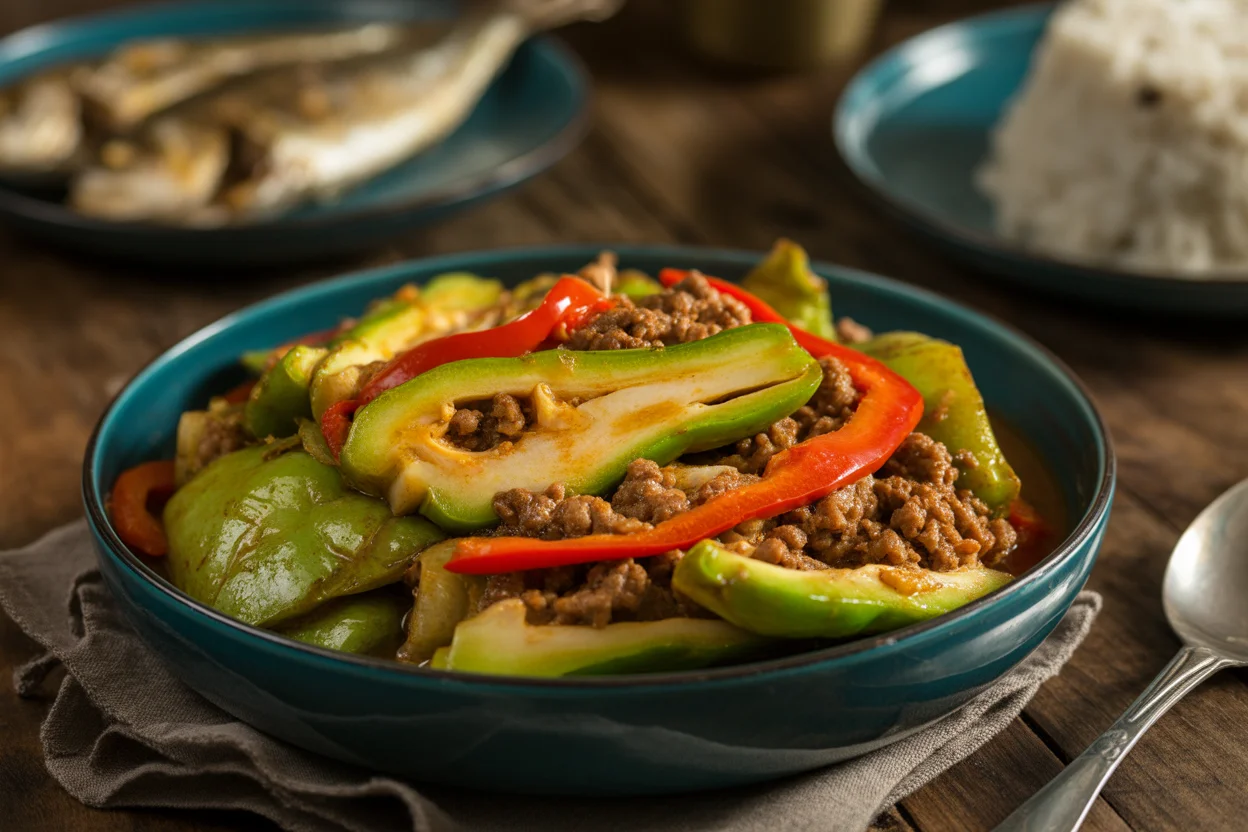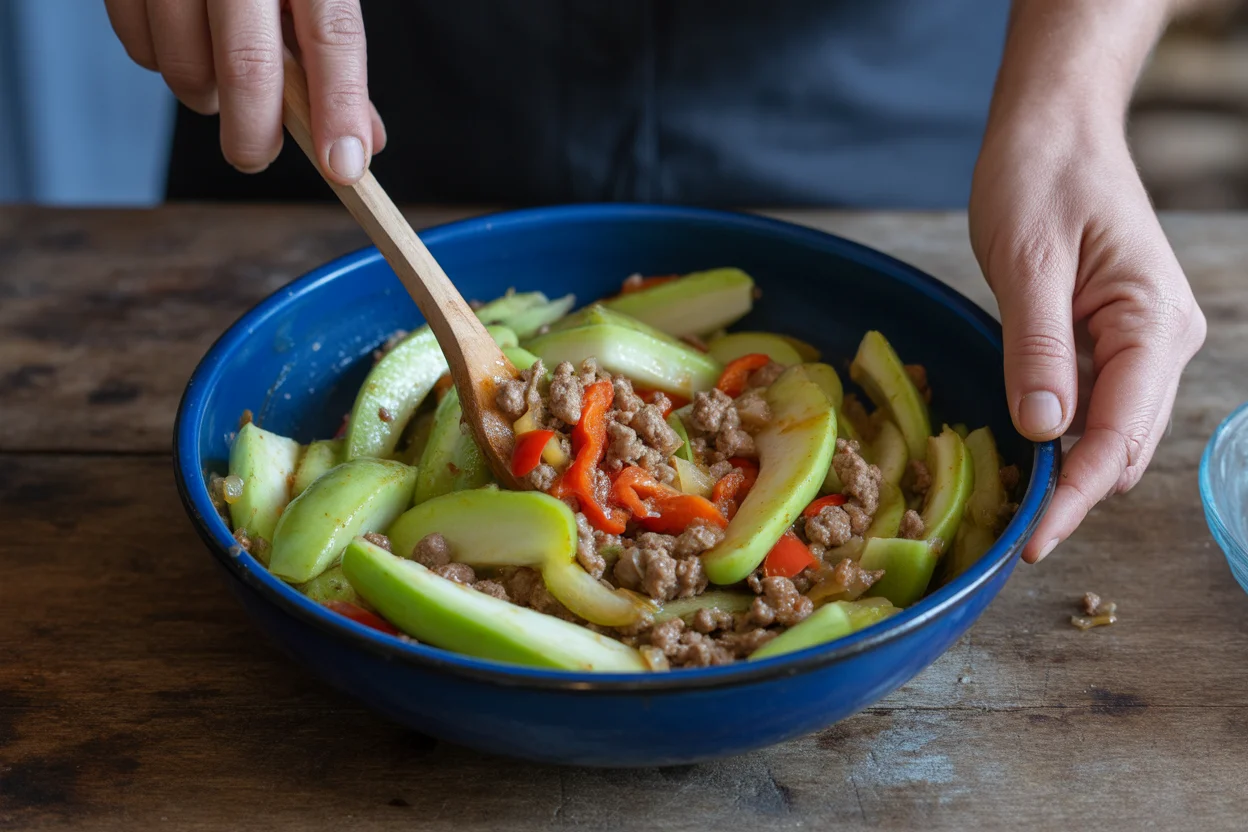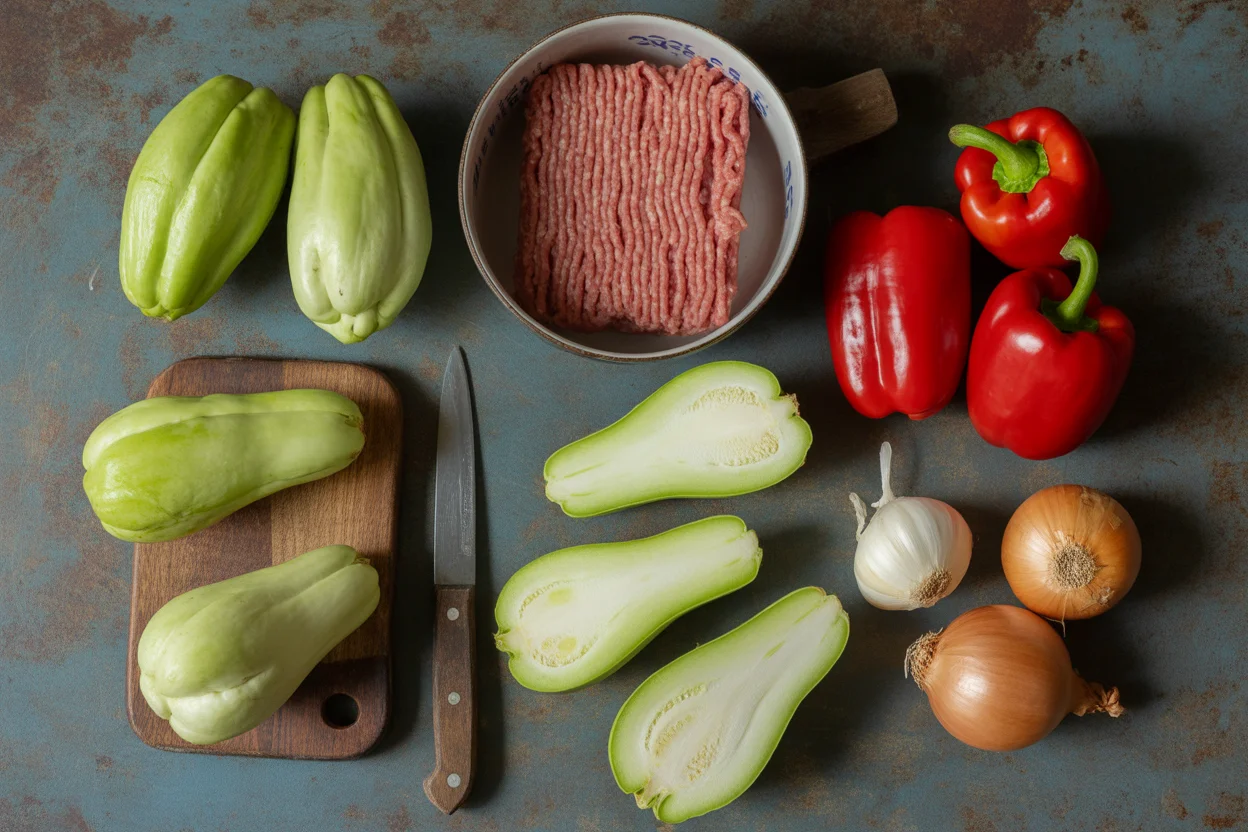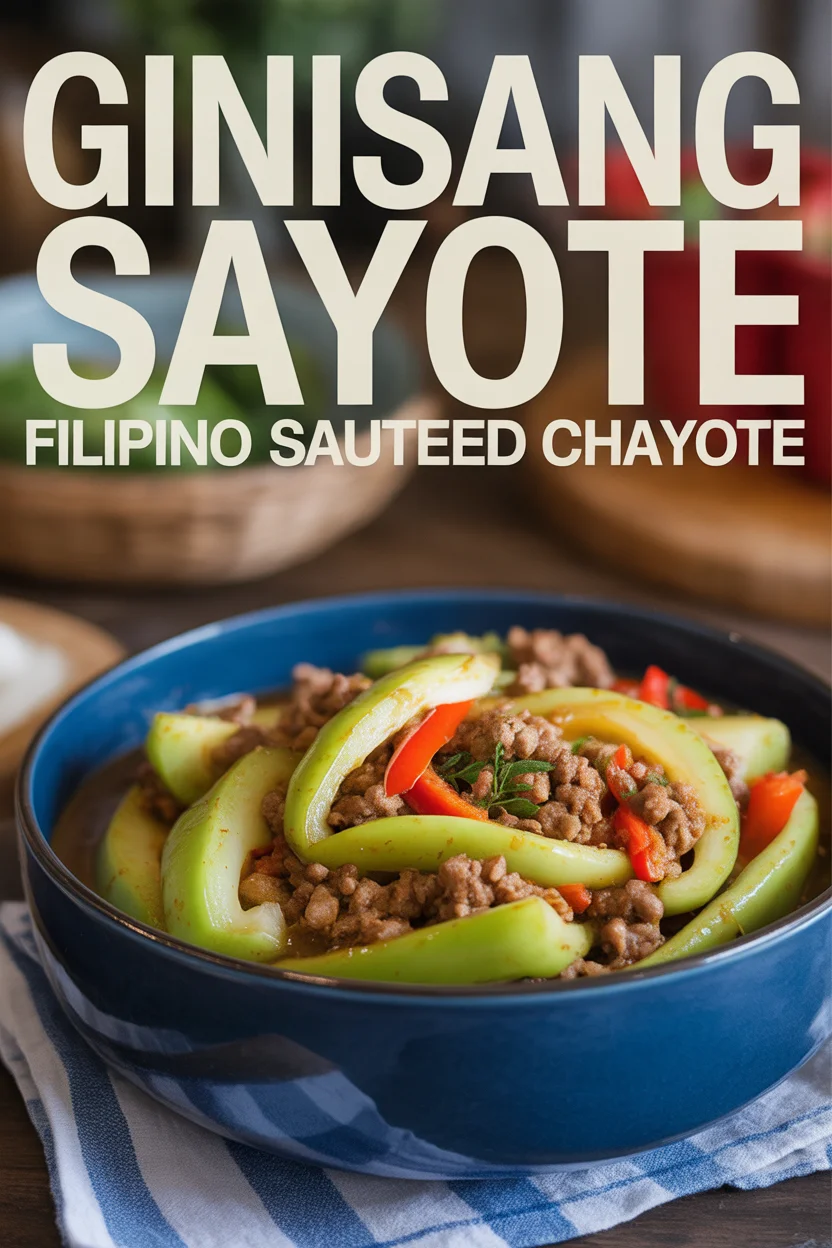- Introduction to ginisang sayote
- Preparing sayote
- Cooking aromatics
- Sauteing with vegetables
- Serving
- Flavor notes
- Easy dish tips
- Common Questions
- Ready to try sayote for dinner?
Filipino ginisang sayote is pretty much my go-to when life gets wild, groceries are running low, or let’s be real – I just want something fast, filling, and healthy (ish). Maybe you’ve had a day like that too? Those moments when you peek in the fridge hoping for magic, but see just a sad chayote and some leftover ground meat? Yup, this happened to me last week. Plus, if you’re into other simple Filipino winners, like this ever-classic bistek Tagalog or stuff the kids won’t fight about, check out these kid-friendly Filipino recipes. But for today, I’m diving into this life-saver of a stir-fry.

Introduction to ginisang sayote
So, what’s the deal with ginisang sayote? I’ll tell you right away, this humble dish is like that underdog in a romcom who secretly steals the show. Ginisang sayote, which translates to sautéed chayote, combines just a handful of ingredients and turns them into a cozy home-cooked meal. Not fancy fancy – but super satisfying and pretty darn healthy.
Chayote is a pear-shaped, light green veggie. Honestly, it gets ignored a lot here in the States. But in the Philippines, it’s a staple in every palengke shopper’s basket. The secret? It absorbs flavor like a soggy biscuit, in a good way.
Here’s what I love: ginisang sayote doesn’t need much. Ground pork or beef (or skip it), sayote, garlic, onion, tomato if you want. Maybe a splash of fish sauce for that oh-so-Filipino oomph. If you can master this, you’re golden with Filipino basic skills.
One time my aunt fed her picky neighbors a batch and – no joke – they asked for seconds, not knowing what vegetable they’d inhaled. Gotta love it.
“I didn’t expect sayote to be this good! My kids actually ate their veggies and asked for more.” – Cecile, fellow busy mom

Preparing sayote
First up – let’s talk about prepping this chayote. I won’t lie, peeling sayote can get a bit slippery, so if you’re awkward in the kitchen (like yours truly, who once dropped one right into the dog’s dish), use a towel to hold it. Slice off the ends, peel the skin, then split the chayote in half under running water. This trick helps wash off that sticky juice – it can leave your hands oddly tingly.
With a spoon, scoop out the white pit in the center. After that, cut the flesh into thin sticks or half-moons, whatever you fancy. No need for a ruler. If you like things uniform, go for matchsticks… but random shapes are totally fine.
Another tip – don’t wait too long to cook after slicing. The edges brown up fast and can look weird. Not unsafe to eat, just a little less appetizing. One of my titas swears by soaking the slices in salty water for a minute. Honestly, I just rinse and get going.
PS: Don’t toss those sayote skins in the trash if you compost – they break down like magic.

Cooking aromatics
Okay, time to bring the flavor! Every decent ginisang sayote starts with aromatics. That means garlic and onion – garlic first, always. Heat up some oil in your pan. Toss in the minced garlic and let it get golden, not brown (I get distracted and end up with burnt bits more often than I’d like). Next, drop in the chopped onion. You can legit hear the tsss and the whole kitchen starts smelling like Lola’s place.
If you’re a tomato enthusiast, slide those in right after the onions. They soften up and kinda melt, turning saucy. No stress if you skip them, though. Sometimes I’m out, and, eh, nobody complains.
Once all that’s bubbling and softened, you’re ready for the real star – the sayote.
A quick note on meat: if you’re using ground pork or beef, throw it in after the garlic and onions, before the sayote. Brown it up and then continue. Want to keep things lighter? Giniling (ground meat) is optional.
Sauteing with vegetables
This is where stuff starts coming together. Throw your sliced sayote into the pan with all those aromatic wonders. Give it all a mix, coat the veggies well. Now’s the time for seasoning. I’m talking about fish sauce (patis), salt, and maybe a crack of black pepper.
Add just a little splash of water if things are sticking – chayote’s got a lot of water itself though, so don’t go wild. Lower the heat, cover up the pan, and let it all steam for maybe five-ish minutes.
You want the sayote crisp-tender; not mushy, not rock hard. It turns see-through-ish when ready (that’s my technical term). Give it a taste. Needs more salt? Chuck some in. You can even add a beaten egg near the end if you want more bulk. Totally optional, but sometimes I do when I’m extra hungry… or trying to stretch dinner for surprise guests.
Honestly, this is so much like making ginisang ampalaya with egg, just with a sweeter veg!
Serving
Now comes my favorite part. Ginisang sayote can be a bit of a blank canvas, so here’s how I roll:
- Always, always with steamed white rice. Brown rice works if you’re feeling health-kick-ish.
- Sometimes I’ll fry up a sunny-side egg to plop on top.
- Got leftovers? Stir them into hot soup, like bulanglang, for “next-level” comfort food.
- If you made a meaty version, try stuffing it in a tortilla. Not traditional, but trust me – it’s a mood.
And if you’re setting the table for family, pair it up with another veggie dish like ginisang monggo so you feel extra accomplished.
Flavor notes
Here’s the wild thing: ginisang sayote is kind of a chameleon. The chayote itself? Mild, a bit sweet, with a gentle crunch. It totally soaks up all that garlicky-onion goodness, kind of like a Filipino version of zucchini, but less mushy.
If you add pork, you get a juicier, meatier flavor. With fish sauce, that magical umami Filipino kitchens are obsessed with. Not spicy unless you add chili, which hey, is fair game for heat lovers.
Growing up, I thought it was bland, but now it tastes like comfort, especially on cold days. My brother claims the sayote’s “weird texture” is what makes it unique. I say it’s why I love it. You’ll just have to try and see.
“Who’d have thought chayote could taste this good? Now my husband asks for it every week!” – Liza, actual sayote convert
Easy dish tips
Let’s keep it real. Some quick hacks for success:
If you’re using ground meat, brown it well for a deeper flavor. Watch the heat so you don’t burn your garlic (burnt garlic is a mood killer). Don’t overcook the sayote – you want a tiny crunch left. Try a drizzle of oyster sauce for a different taste. Want to really bulk it up? Add carrots or bell peppers. More color, more nutrition, less boredom. Also – this dish reheats like a dream. Meal-preppers, rejoice!
Common Questions
Can I use chicken instead of pork or beef?
Absolutely! Shredded leftover chicken, chicken breast, whatever. No rules here.
Is ginisang sayote healthy?
For sure. Sayote is super low-cal, packed with fiber, and not much fat (unless you throw in lots of pork, ha!). It’s one of those healthy Filipino recipes I rely on for weekday dinners.
Do I need fish sauce?
Nope. You can replace with salt or soy sauce if fish sauce weirds you out. I like the fish sauce hit, though, for the extra savoriness.
How do I keep the chayote from turning brown after slicing?
Work fast, rinse under water, and cook right away. If it browns a bit, honestly, it’ll taste the same.
What else can I add?
Lots! Shrimp works great, and some folks add tomatoes, egg, or even tofu. Make it your own.
Ready to try sayote for dinner?
Life’s busy and sometimes all you need is a recipe that’s easy, filling, and friendly for wallets (and busy schedules). Ginisang sayote is honestly a “hidden gem” in Filipino homes – so simple and so easily adapted to what’s in your fridge. If you want more step-by-step inspo, check out Ginisang Sayote (Sautéed Chayote) – Foxy Folksy Pinoy Recipes or the classic Ginisang Sayote Recipe to see what twists you might like. Trust me, once you try it, you’ll understand why this one ends up on the dinner table again and again. Give it a go tonight – your future self will thank you!

Ginisang Sayote
Ingredients
Main Ingredients
- 2 pieces sayote (chayote) Peeled and sliced into sticks or half-moons
- 1 cup ground pork or beef Optional ingredient, can be omitted for a vegetarian version
- 2 tablespoons cooking oil For sautéing
- 3 cloves garlic Minced
- 1 medium onion Chopped
- 1 medium tomato Chopped, optional
- 2 tablespoons fish sauce (patis) For seasoning, can be replaced with salt
- to taste salt and pepper For additional seasoning
- 1 egg beaten, optional Add near the end for extra bulk
Instructions
Preparation
- Peel the sayote while holding it with a towel to prevent slipping. Slice off the ends and halve it under running water to wash off sticky juice.
- Scoop out the white pit in the center and cut the flesh into thin sticks or half-moons.
- Rinse the slices and avoid letting them sit too long to prevent browning.
Cooking
- Heat oil in a pan over medium heat. Add minced garlic and sauté until golden.
- Add chopped onion and cook until softened. If using, incorporate chopped tomatoes and stir until they soften.
- If using ground meat, add it to the pan and brown it before adding the sayote.
- Add the sliced sayote and mix well to coat with aromatics.
- Season with fish sauce, salt, and pepper. Add a splash of water if it sticks.
- Cover and steam for about 5 minutes until the sayote is crisp-tender. Optionally, stir in a beaten egg near the end.
Serving
- Serve the ginisang sayote with steamed white rice. Optionally top with a fried egg.
- Leftovers can be added to hot soup or used as a filling in tortillas.

